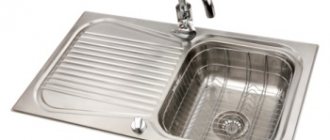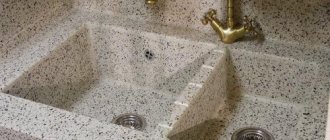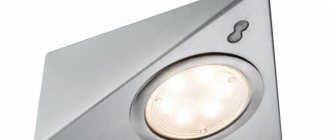Welded washing bathtubs are used in public catering establishments and are intended for washing kitchen utensils and utensils, defrosting food products, etc. The washing tank of the bathtub is made of AISI 430 stainless steel, welds and edges are thoroughly cleaned and specially processed. The frame of the washing bathtubs is made collapsible for ease of transportation; the legs are equipped with height-adjustable supports.
Sinks for standard worktops 60 cm wide
According to generally accepted kitchen standards, the optimal width of the countertop is 60 cm. It is believed that this size of the working surface allows you to conveniently place kitchen appliances and plumbing fixtures, does not clutter up the space and is sufficient for cooking. A 50 cm kitchen sink is designed specifically for such countertops.
We have the largest selection of sinks for standard work surfaces on our website - more than 300 models. Sinks with a width of 50 cm come in different designs:
- single bowl;
- with wing for drying;
- with additional bowl;
- double-cup.
It is not recommended to install the sink close to the wall, since in this case the range of action of the mixer is reduced, and it may be difficult to switch the lever; in addition, water may accumulate at the joint. The optimal distance from the wall is 5 cm. This will be enough for the lever to move freely and clean up spilled water; in addition, this space can be conveniently used for storing detergents or cutting boards.
The distance from the sink to the front edge of the countertop should also be about 5 cm. If it is smaller, splashes of water while washing dishes can wet your clothes; if it is larger, it may be inconvenient to reach the mixer lever and detergents.
Single-bowl sinks are ideal for small kitchens. Sinks with additional bowls and draining wings are designed for spacious kitchens. Such models, as a rule, have a reversible design, i.e., for a left-handed person, the wing or shallow bowl can be installed on the left, and for a right-handed person, on the right.
How to choose?
By following a few simple tips, you can quickly and easily choose a stone sink made from granite chips:
- It is advisable to determine the shape, size and material of plumbing fixtures at the stage of designing kitchen furniture. This approach will save money and time searching for a product with the desired parameters and colors.
- Before looking for a sink for a finished cabinet, you need to measure its dimensions: the distance from the edge of the countertop to the sanitary ware should not be less than 5 cm.
- For a small kitchen with a narrow countertop, it is better to choose a narrow rectangular sink with a single bowl and drainer: this arrangement will allow you to install plumbing with acceptable parameters and allow you to wash dishes comfortably.
- If the installation location is a corner cabinet, it is better to choose a sink with identical outlines, pentagonal or hexagonal, with several bowls for more rational use of the workspace.
- Large sinks are ideal for a large kitchen. Such plumbing will allow you to perform several operations at the same time: washing dishes, food, defrosting meat, vegetables.
Stainless steel kitchen sink: what properties should the material have?
The sale of a quality product is accompanied by the provision of a passport, which must contain a mention of the type of steel used and the compliance of the steel grade with the Russian standard R 50851-96 or the international standard ISO 9001.
Manufacturers set sheet thickness within a fairly wide range - from 0.4 mm to 1.2 mm. It is made from steel of the following grades:
A sink made from high-quality food-grade steel will cost more than a product made from ordinary stainless steel.
AISI304 (other designations may be used in marking - 304 or 08Х18Н10). When purchasing a product manufactured by a European manufacturer, you may encounter the following marking options - (EN) 1.4301 or (DIN) X5CrNI18-10. In an alloy marked in this way, the carbon content is assumed to be below 0.8%, the combination of chromium (18%) and nickel (approximately 8-10%) is considered ideal. This option is preferable, since special food grade steel is used. To buy a stainless steel kitchen sink of this brand, you will have to shell out a relatively large amount.
AISI204. Another marking is 204. Steel grade 204 is easier to process, which affects its cost and the cost of products made from it. By purchasing a sink made of 204 stainless steel, you will be able to spend less money. It will not last as long because the alloy contains much less chromium, which provides strength. Even more important is the low nickel content, which provides resistance to corrosion processes.
Alloying of the steel used in the manufacture of the sink affects strength, ductility and corrosion resistance, and is manifested in the characteristic shine of the surface, which is easy to polish.
The alloy steel sink features a smooth and shiny surface
On a note! Sinks with a mirror surface are usually classified as “luxury” and, contrary to popular belief, they are much easier to care for than others.
Not very conscientious manufacturers of stainless steel kitchen sinks make them from inferior quality steels, which are intended only for technical use. When dealing with material with the Russian marking 12X17G9AN4 or the European DIN - X8CrMnNi188, you should understand that AISI202 grade steel is used. Therefore, it is quite possible that over time, traces of corrosion will appear in places of stress (bends or seams), the color will change, and the surface will become covered with structural stains.
Therefore, you should not purchase a stainless steel sink for the kitchen through an online store, but select it in a real shopping center, so that you can be sure of its quality not only through visual inspection. Namely: a magnet will help you understand that the design is made properly, from an alloy with suitable properties for use in the kitchen. It is assumed that its sliding along the surface of the product should be unhindered. The sticking of a magnet to the vertical part of the structure unmistakably indicates the low quality of the material used.
The stamped kitchen sink has no seams
What types of surfaces are there in artificial stone?
The working surface made of artificial stone can be of three types: matte, glossy and semi-matte. Not only the appearance, but also the operating conditions depend on this. For example, a glossy base is less practical due to the fact that scratches or other minor damage are more visible on it.
A matte hard surface made of artificial stone is suitable for those who are concerned about the safety of their appearance. Marks and scratches are least noticeable on white or cream, matte sinks. If you have a dishwasher and use the sink less often, then you can choose semi-matte options. Another advantage of a matte sink made of artificial stone is that such a surface does not reflect glare from the sun, and there are no traces of hard water.
The semi-matte option is an alternative to matte. You should immediately remember that it is rational to select the type of surface according to the type of countertop. A matte sink does not always fit under a glossy base. Often, when renovating, the countertop and sink are connected. Due to this, even the joints will not be noticeable.
Gloss is more suitable for those who do not wash dishes in the sink itself, but use a dishwasher. Due to this, traces of metal utensils will not remain on the surface. On a light gloss finish, scratches and marks from use are least noticeable.
Features of stainless steel kitchen sinks
A modern stainless steel sink is the most effective and ergonomic option for a kitchen of any design, fitting perfectly into any interior design.
Defining Benefits
- Reliability. A stainless steel kitchen sink is capable of holding a significant weight of dishes, along with food, as well as a high temperature of 1450 °C! Thus, it not only copes with hot frying pans thoughtlessly thrown into the sink with courage and dignity, but also provides powerful resistance to heavy containers and voluminous cauldrons.
Stainless steel kitchen sinks are not afraid of corrosion and scratches, they effectively withstand impacts, and stainless steel itself is so flexible that even a ceramic plate dropped into the sink bowl is quite capable of getting away with a fright.
- Practicality. The stainless steel sink is quite unpretentious: it is enough to clean it occasionally with a dishwashing sponge and a cleaning agent. In addition, this model easily tolerates disinfection using complex and aggressive chemicals. Since there are no pores on the surface of such steel, then, accordingly, there are no contaminants in them.
- Low cost. The inexpensive price of a stainless steel kitchen sink pleases consumers: on the Russian market, a standard sink model can be purchased quite cheaply, for about 800 rubles.
- Variety of shapes and compositions. On the specialized market you can find a wide selection of stainless steel sinks for the kitchen: exclusive in shape and size, non-standard design and stylish texture. You will easily find the very kitchen sink you have been looking for for so long.
- Environmental friendliness. If you are a supporter of eco-design, then you should definitely take a closer look at this stainless beauty. The material of this type of sink is ideally recycled, and it can also be melted down.
Built-in stainless steel sink (photo)
Serious shortcomings
However, this integral attribute of the kitchen interior, in addition to significant advantages, also has qualitative disadvantages, which often make a person think several times before purchasing this type of sink.
- Noise. This is perhaps the main disadvantage in using stainless steel sinks. The low degree of noise absorption, in particular in sinks with a thin bottom and wall, is often not in favor of such models: falling drops of water make loud and sharp sounds. Therefore, when purchasing such a design, prepare for the fact that you will also have to spend money on installing sound insulation under the sink itself.
- Mixer mount. We are talking about sink models made of low-quality metal: faucets on such systems are not attached tightly enough. That is why, when you turn the tap or open the water, you can see how the surface of the bowl moves slightly, which is why the mixer begins to “move.”
- Need grounding. For safety reasons, a stainless steel sink must be grounded if various electrical appliances are located near it.
Dimensions
The dimensions of kitchen sinks are very important when choosing the appropriate option, so you should pay attention to values such as: length, width, depth, height, etc.
Length
This value can be obtained by measuring the shell from the front to the back edge. You should choose the optimal length for yourself based on the needs of the housewife. Some people use the sink to wash a large number of dishes every day, not only small but also large ones, while others only need to rinse a few mugs and plates.
The size of the sink is selected in accordance with the length of the countertop, so before purchasing you need to rely on its dimensions. Do not forget that around the sink, and especially against the wall, there should be a free space of 50 mm.
Width
No less important parameter than length. The width of the kitchen sink depends on the amount of free space and the size of the countertop and cabinet. For a small kitchen, it is most rational to use a corner module for a sink and sink of a round, rectangular, trapezoidal shape.
Narrow options are also suitable, but only if you do not need to constantly wash baking trays and large dishes. Otherwise, the operation of such a sink will be inconvenient.
The presence of a wing for drying dishes and food in the side of the sink significantly increases its size, but at the same time adds functionality. When choosing such a sink, you should give it more space on the countertop.
Depth and height
In addition to the length and width, it is important to take into account the depth and height of the sink bowl. The depth parameter determines the capacity of the sink; the deeper the bowl, the more dishes it can hold (the optimal depth is from 160 to 190 mm). The height of the mixer is also important. You should not make it too high, as during the washing process too many splashes will fly around.
Bowls with a depth of more than 200mm are suitable for large dishes and baking trays, while shallow sinks less than 160mm are more suitable for a bathroom than a kitchen. Small round or narrow sinks most often have a deeper bowl than sinks of the usual dimensions.
The height of the sink depends on the size of the cabinet into which it is embedded. So, standard values are 900-950 mm. These settings are suitable for the average person and will be comfortable when washing dishes or food, ensuring minimal strain on the back and neck.











